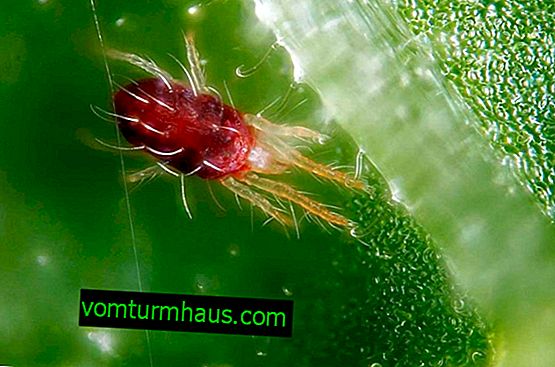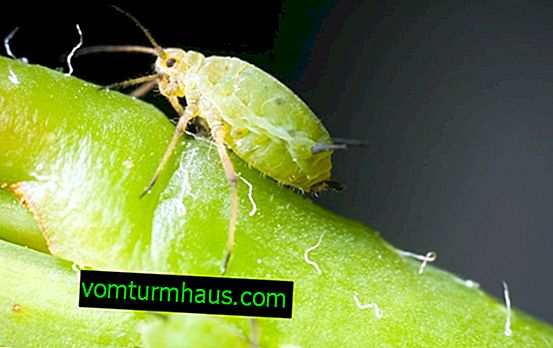Hoffmania: home care
Among the many indoor plants, this flower is capricious in care. It attracts attention with its corrugated sheets with a clear texture pattern of symmetrically located veins, as well as colorful color transitions on them. The article will tell you about the intricacies of growing, care and breeding gofmanii, including the difficulties that you may encounter.
Botanical description of the plant
Hoffmannia (Hoffmannia) belongs to the Marenov family. The described culture includes up to one hundred species of not too large shrubs and perennial grasses (with an area of growth throughout the Central and South American continents).

| Stem | Erect (prone to lodging), 30-100 cm high, branching, juicy, reddish |
| Leaf shape | wrinkled, obovate; opposite, sessile; 15-30 cm long and 10 cm wide |
| Leaf color | top: olive green with satin sheen; bottom - with a pinkish-red tint and red veins |
| Flower shape | axillary umbellate inflorescences; diameter - up to 2.5 cm |
| Flower color | light red or beige pink |
| Fruit shape | spherical or cylindrical; fruits up to 9 mm in length |
| Fruit color | reddish or pink |
Did you know? Due to the alkaloids contained in all types of gofmania - caffeine, quinine, emethine - these plants can have a significant effect on the human nervous system. In small doses, these substances even have a therapeutic effect (dilate or narrow vessels, anesthetize), in high doses they are poison.
The main types
Despite the wide variety of described shrubs, only three of their species are cultivated:
- Hoffmannia is radiant, or Hoffmannia shines. It has a shrubby growth form, reaches 35-60 cm in height. Strong and juicy stems grow straight, branch, painted in red tones; shoots are slightly faceted. Opposite leaves have a glossy satin sheen, wrinkled; in length reach 8-12 cm. The color of the upper surface of the leaves is greenish-olive, their lower part is red. The plant periodically blooms with small umbrella inflorescences with red flowers growing in the axils of the leaves directly from the trunk. The buds when opened have a diameter of up to 2.5 cm, corollas with limbs and four petals.

- Hoffmannia Rezl (velvet). The stems of the culture reach 30 cm in height, 4-faced and fleshy, with a reddish tinge, pubescent with short brown hairs. Leaf blades at the base are elongated, and pointed at the tops. The leaves reach a length of over 20 cm, their width is from 10 cm. The upper part of the leaves is velvety, with an olive-green color and a reddish-brown tint, which gives the plant a special decorative effect. The inflorescences are dense, racemose, with brownish-reddish flowers in diameter up to 1.8 cm.

- Hoffmannia Gisbrecht (Gisbright). Shrub plant with large velvet leaves, painted in pinkish and whitish tones (the main color is dark green). The lower part of the leaves with a purple-red tint. Star-shaped flowers with yellow petals and red spots. Inflorescences are located in the axils of the leaves and attach to the stems. The plant is grown exclusively in greenhouses.

Growing conditions
Hoffmania is a maladaptive tropical plant that requires comfortable conditions, otherwise it may lose its decorative effect. To grow it you need certain conditions.
Important! The leaves of Hoffmania must be protected from contamination during the cleaning of the apartment. Dust that has fallen on the leaves must be carefully cleaned with a soft brush.
Accommodation
The most optimal places to place the capricious "Tropicana" are:
- indoor greenhouse;
- flower showcase;
- florarium;
- greenhouse;
- winter Garden.












The location for the plant must be chosen, taking into account some more nuances:
- You can place the culture in a bright place with diffused light, in partial shade and shadow;
- Be sure to protect from bright and direct sunlight;
- the plant does not tolerate drafts;
- dry air from heaters has a bad effect.

Temperature mode
The shrub is extremely demanding on a stably high air temperature. If the temperature column drops to + 18 ° C, then this causes stress in the plant. Lower temperature indicators will significantly affect the appearance and health of the culture.
Air humidity
The plant is sensitive to excessive dryness of the air, therefore, sharp fluctuations in humidity in the room due to the operation of air conditioners and heating devices affect it destructively. The optimum humidity in the room is 75-85%.
Did you know? A quarter of all natural medicines manufactured by world pharmacology are prepared on the basis of tropical plants.
Home Care
The conditions for keeping gofmania in the apartment differ from those that are familiar to her in the natural environment. But if you provide her with thorough care, you can achieve good results.

Watering and spraying
Since the velvety bush of Hoffmannia is hygrophilous, in an apartment it needs to be regularly and abundantly watered and often sprayed. Low humidity in the room is compensated by the following methods:
- spray the bush with warm water, always boiled, since sedimentary salts from tap water will lead to a loss of decorativeness of the delicate velvety leaves of goffmania;
- spray water should be 5 ° higher than air temperature;
- for spraying use only fine sprayers;
- plants are placed on pallets filled with moist expanded clay or pebbles;
- they cultivate the culture in a double tank by installing a pot with a plant in a bowl with wet pebbles;
- indoor equipment for humidification;
- next to place an aquarium or indoor fountain;
- watering is carried out after the top layer of the earth in the pot is sufficiently dry;
- in summer and spring, the bush is watered 2 times a week, in autumn and winter, watering is reduced.
Important! Misses in watering gofmanii should not be allowed. The complete drying of the earthen coma and its overmoistening harm the plant.
Top dressing
It is necessary to feed the bush during the period of active vegetation - from May to September, with an optimal frequency of feeding - 1-2 times in 7 days. Since the plant is very sensitive and prone to root burns, liquid fertilizers are prepared for it, which are applied carefully after abundant moisture in the soil.

The best dressings for gofmanii are:
- organic fertilizers (mullein);
- universal mineral-organic preparations (the concentration of the solution of such preparations is half that recommended by the manufacturer).
Pruning
Since the plant grows at a fast pace in summer, and actively drops the lower leaves in winter, due to which it can lose its decorative effect. To do this, in the first days of spring, deep trimming of bare trunks is done. The remaining "stumps" will give rise to new shoots, lushly covered with young greenery. To stimulate the formation of thick tops, pinch new branches. From the trimmed parts of the shrub, you can prepare cuttings for propagation.
Did you know? Many indoor flowers have antibacterial properties that can destroy bacteria faster and more efficiently than volatile, which contains garlic.
Transfer
Capacities and substrate for velvety bushes change as they grow strongly and are developed by the roots of the soil in the pot (usually 1 time in 2 years). Each year, the topsoil in the tank is replaced.
Here are the principles of transplanting goffmania:
Recommended Reading

- the process is carried out at the end of winter or early spring;
- prepare a new flowerpot with a diameter 5 cm wider than the previous one;
- the bottom of the pot is equipped with holes for draining excess fluid;
- to prevent moisture stagnation, a layer of expanded clay or pebbles (2 cm) is laid at the bottom;
- prepare a light and loose substrate, slightly acidic in chemical composition (it is better to get it in a specialized store);
- with independent mixing of the soil, the following composition is prepared: peat, leaf soil, sand (1: 1: 1) with a small addition of humus;
- replanting the bush, it is unacceptable to expose the roots, it is advisable to keep the earthen lump intact;
- after transplanting, the plant must be abundantly watered and put in a shaded place in the greenhouse (window).
Propagation by cuttings
There are several methods of breeding gofmanii, among which - cuttings.
To do this, use the following process:
- branches obtained from pruning (with three internodes and up to 10 cm long), or the broken tops of young shoots are placed in powder for rooting;
- root the cuttings in a light substrate (a mixture of peat and sand), and cover with transparent caps;
- Mandatory conditions for proper rooting are increased air humidity; heating the flowerpot from below, the temperature in the room + 21- + 30 ° С; penumbra;
- regular moistening of the cuttings and their ventilation is necessary;
- after the formation of young leaves on the stems, the cuttings are transplanted into large containers of 2-3 plants; after that, the pots are rearranged in a more illuminated place, protecting the plant from direct sunlight.

Growing difficulties
Of the difficulties in growing velvety bushes, plants distinguish the following:
- diseases
- pests.
Disease
Hoffmania can be sick due to improper care, so it is very important to monitor the condition of the shrubs and eliminate problems and their causes in time.
Among the reasons are:
- Withering bush due to insufficient moisture or cool content. It is necessary to establish regular watering and spraying; increase the room temperature to an acceptable (+ 21- + 30 ° С).
- Due to excessive watering, a loss of foliage turgor occurs, followed by wilting of the plant. It is necessary to adhere to the optimal watering regimen (no more than 2 times in 7 days).
- Rotting stems and roots due to abundant moisture. Do not exceed established watering rates.
- The ends of the leaf blades dry during irregular watering and low humidity in the room. Regularly moisturize an earthen coma, as well as spray each leaf with warm boiled water.
Learn how to plant indoor flowers in a pot.
Pests
Hoffmania in a weakened state is sometimes affected by pests, among which:
- Spider mite. The pest appears when the room is dry. For prevention, the room maintains increased moisture; the bushes are sprayed twice or thrice a day. Severe infection is eliminated with the insecticides "Actellic" or "Actara".

- Aphids, thrips. Damage occurs if the plant’s moisture regimen is disturbed for a long time. Pest control measures are the same as in the presence of the previous parasite.

If you create gofmanii all the necessary conditions - sufficient heat, high humidity, optimal watering and regular top dressing, then it will delight you with its decorative look and unusual beauty for a long time.








